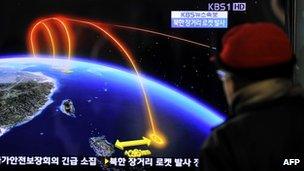Key step in North Korea's missile ambitions
- Published

The rocket launch was widely condemned in the region
North Korea's successful launch of an Unha-3 rocket marks a significant step forward for Pyongyang's ambitions to develop an intercontinental ballistic missile (ICBM).
The launch, according to the North American Aerospace Defence Command, external "deployed an object that appeared to achieve orbit".
North Korea says the purpose of the launch was to place a satellite into orbit, though in the past Pyongyang has boasted of its ambitions to be able to strike at what it calls "aggressors", however far away they may be.
Experts note that the technology involved in a satellite launch is similar to that needed to develop a very long-range missile.
Mark Fitzpatrick, director for non-proliferation and disarmament at the International Institute for Strategic Studies (IISS) in London, external, says: "The fact that the North Koreans may have placed a satellite in orbit is less significant than the fact that they appear to have achieved a successful separation between the three-stages of the rocket."
"This," he adds, "certainly furthers their ICBM ambitions."
'Worst-case prediction'
This is the second North Korean long-range missile test this year. The first - in April - was a failure.
Nonetheless, experts have been struck by the rapid acceleration of Pyongyang's testing programme, which up to now has been conducted at a much more leisurely pace.
In January 2011, the then US Defence Secretary Robert Gates warned during a trip to China that within the next five years North Korea would have developed an ICBM, potentially able to strike the US.
However, he underlined that this would be "a very limited capability".
So is North Korea on track to develop an ICBM in this time-frame?
Mr Fitzpatrick thinks not. In his view, Mr Gates' comments were "a worst-case prediction" that he believes "will probably turn out to have been exaggerated".
The North Korean test is certainly a step forward but this launcher is in itself not a weapon.
Elaborate fake?
"Putting something up in the air," says Mr Fitzpatrick, "is only part of the problem. You have to bring it down to earth. You need a warhead that is small enough to fit on top of the missile."
"And," he continues, "you need an elaborate form of shielding to protect the warhead against the intense heat and buffeting experienced during re-entry into the earth's atmosphere."
In his view, "North Korea is not going to have a weapon in the near future".
To develop a nuclear warhead that is sufficiently small but reliable, many experts believe that North Korea will have to conduct further nuclear tests - not least because the two that it has carried out have been only partially successful.
The Unha rocket is one source of concern for the Americans and their allies, but experts note that its technology might not make a great weapon. It had to be assembled and fuelled in full view over a number of days.
Last spring, North Korea paraded a new long-range missile carried on a wheeled-launcher. Since then debate among Western experts has swung back and forth - were these real missiles or just an elaborate fake?
Mr Fitzpatrick believes that "they probably were mock-ups, but nonetheless mock-ups of something real" - a pointer to the direction in which North Korea's technology is heading.
"This kind of mobile system," he says, "would give North Korea a much more survivable ICBM capability."
A basic North Korean ICBM capability would have to contend with the limited defensive system that the US has already deployed to guard against missile attacks.
This is largely orientated at the moment against a potential threat from Iran.
But clearly if Pyongyang's programme is seen as picking up speed, then US advocates of missile defence might seek to ensure that their system can protect the continental US from this direction as well.
